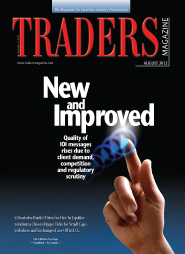The once much maligned indication of interest has been reinvented. The buyside has long complained that these electronic messages from brokerage firms, expressing willingness to trade a block of stock, were nothing more than fishing expeditions to capture an order.

Too much noise. Too little information. No real order. Those were the complaints of the buyside about what are commonly referred to as IOIs. But something has happened in the last year to dramatically improve the quality of IOIs—and clients’ attitudes toward them. Messages to clients are accurately marked as natural liquidity when an IOI represents a client order on the other side of the trade. And if an IOI reveals that a broker is willing to commit capital, a so-called “super,” it too, for the most part, is clearly marked for clients to decide if they want to interact with an it.
It was a challenge for the buyside to view the tens of thousands of IOIs broadcast every day. They had to figure out which were natural liquidity and which were just looking to glean information about their trading intentions—and snag an order. But today, the sellside tiers their IOIs and targets them to select clients who are more likely to trade a particular stock, based on their holdings. Consequently, the IOIs that go out today are better than they’ve ever been.

So what happened? First, the buyside told the sellside to clean up its act—to clearly mark IOIs as natural when an order is behind them. The sellside complied in the recent downturn, as it saw the continuation of low trading volumes and falling commissions. The last thing it wanted was to alienate a client and have its IOIs from the high-touch desk ignored by a trading partner.
The other factor was regulatory: The Financial Industry Regulatory Authority began a crackdown on mismarked IOIs from brokers last October. But traders say the industry was already improving things before FINRA got involved. FINRA only speeded up the process.
“The best way IOIs have changed is that the sellside has taken a lot of the noise out,” said Kevin Chapman, managing director and head of trading at San Diego-based Allianz Global Investors Capital. “The sellside now sends IOIs that are for the most part naturals that want to trade.”
Eric Johnston, head of Americas cash trading at Barclays Capital, said the buyside decides where to route its orders based on who provides the best high-touch, block liquidity. And that is where IOIs enter. If a broker sends out good-quality IOIs, ones backed by an order, the buyside is interested.
“The buyside is increasingly taking into account the quality of their brokers’ IOIs,” Johnston said. “Quality has been defined as how tight is an IOI to the last sale, the size behind the IOI, and whether it is a live natural when the buyside tries to interact with it. The buyside is increasingly focused on natural IOIs.”
He added, more than ever, natural IOIs are incentivizing the buyside to trade with high-touch desks, because of the challenging and fragmented liquidity environment. The buyside is willing to pay the high-touch commission rate to find that block liquidity. “Finding quality block liquidity has become very important to the buyside,” Johnston said.
Self Policing
But not everyone equates the quality of an IOI message with a natural cross. One buyside trading exec said that he is willing to trade with a broker out of its inventory if the shares originally came from a capital commitment trade with another institution.

But natural or not, IOIs help the sellside produce trades. Brokers said the importance of IOIs continues to increase as a result of declining trading volumes in the myriad marketplaces. Trade sizes have fallen as overall volume has declined, though the number of trading venues has not gone down. Also, the buyside’s increased concerns over information leakage make using IOIs attractive.
“Essentially, the buyside is tired of trading in a fragmented marketplace and wants to go back to trading blocks more directly with institutions,” Johnston said. “That’s what they’re trying to accomplish, and in finding the best mechanism to do that—it’s come down to IOIs. The market isn’t getting less fragmented.”
The buyside’s frustration regarding the lack of block activity is evident when you look at a Tabb Group survey from June. The buyside said it would like to trade 31 percent of its order flow via blocks. That’s a far cry from the reported 12 percent these traditional asset managers reported executing. And that 12 percent is down from 15 percent in 2010’s survey.
When looking at the buyside’s workflow, the first place a trader checks to find liquidity is IOIs. To do this, they can rely either on their brokers to vet and send IOIs or on vendor platforms. Keith Collazo, equity trader at New York-based Tocqueville Asset Management, which manages $10 billion in equities, said he uses Bloomberg or AutEX to view IOIs.
The use of vendors as a primary means of seeing IOIs is corroborated by a recent survey conducted by Credit Suisse. Only 25 percent of buysiders said IOIs are electronically integrated into their order management systems. Nearly half of the survey’s respondents, 46 percent, said they were not getting IOIs through their OMS at all.
The survey also points out the importance of IOIs. Credit Suisse learned that about 5 percent of its survey respondents are crazy about IOIs: They do between 65 and 100 percent of their business through them. The next group of heavy users amounted to 11 percent of respondents, who do from 35 to 65 percent of their trades through IOIs. The survey also found that 42 percent execute between 10 and 35 percent of their trades via an IOI. And another 42 percent, or mearly half, do 10 percent or less of their trades that way.
This last group is a segment of the buyside that brokers could cultivate to grow their high-touch business. Refining their IOIs might be one way to do so. Bank of America Merrill Lynch’s Bob Moir, chief operating officer for the Americas cash equity trading desk, realizes he only has a few seconds to get a buyside trader’s attention. So the BofA Merrill desk tries to make its IOIs information-rich. The more data in the IOI, the more likely it is to spark a phone call to his desk.
“We can send enough information in the IOIs that show some level of our intent without revealing too much information,” Moir said. “We also try to be more specific in which IOIs we send out to clients. We want the buyside to focus on our IOIs and make ours stand out from the noise.”
However, more data, such as bid or offer prices within an IOI, can make the indication look more like a quote. This has drawn the attention of regulators who are concerned that IOIs resemble actual quotes but are only being shown to select traders.
FINRA has warned the sellside that it cannot label IOIs as naturals without a firm customer order behind them. In the past, brokers have marked IOIs as natural when they reflect a broker’s proprietary position.
As a result of this regulatory scrutiny, the sellside has stepped up and improved the quality of IOIs on its own. The sellside knows its IOIs can make or break a relationship and has policed itself, making sure the IOIs it offers are clearly labeled and accurate. This has helped keep the brokers in good graces with both the buyside and regulators.

“Brokers need to be responsible and send quality IOIs,” said Dan Royal, co-head of global trading at Denver-based Janus Capital Group, which manages $160 billion in equities. “If I keep responding to an IOI and it ends without a trade, chances are I’m not going to call them anymore.”
Many on the buyside say they want a better communication process when trading blocks, one that keeps intentions quiet and keeps adverse price movement in a stock to a minimum.
To achieve this, some buysiders have pushed for actionable IOIs—messages that lead to a trade with the ease of a single mouse click.
This IOI ideally pops up on a trader’s desktop. It is a message containing trade information that can be clicked on immediately and executed as a trade. Considered by many to be the Holy Grail in IOIs, actionable indications take on some of the characteristics of a firm quote sitting on an exchange or ECN.
“We want to be able to click on an IOI and get a trade done,” AGI Capital’s Chapman said.
For example, Chapman offers a case in which he’s buying 200,000 shares of X and has placed an order for only 25,000 because it’s illiquid. It would be valuable to him if his order management system showed an IOI pop-up that said, “Seller of 50,000 shares of order X online. Do you want to buy them?” and he could simply click “Yes.”
And now both the buyside and brokers are looking to the next generation of IOIs, such as actionable IOIs, to boost block-trading volume.
Human Touch
So is technology the future of block trading? Yes. However, the sales trader will still play a vital role in matching buyers and sellers—even in an actionable IOI environment. While IOIs are expected to play a bigger role in the future of block trading, humans will still be needed.

“The trading of blocks won’t go fully electronic,” said Pankil Patel, who heads Credit Suisse’s electronic trading group of the Americas. He compared the current state of IOI adoption to the early days of algorithms last decade. It is relatively unused by some buyside traders, given that only 25 percent of the buyside has IOIs integrated into their OMS.
The future, he added, will see increased usage of IOIs but they will not replace any dealer’s block trading desk.
Patel said actionable IOIs will leverage instant messaging and other low-touch communication channels to make the block-trading process more electronic and efficient, eliminating the need to pick up the phone in some cases.
BofA Merrill’s Moir said there are times where actionable IOIs would be the preferred method of sourcing liquidity, but there are others when they are not. Still, his expectation is that the value provided by institutional sales traders will remain in the vast majority of trading circumstances.
“In certain cases, if that’s what suits a client’s need [actionable], we plan to provide it,” he said. “Likewise, there will be situations where more negotiation and information sharing provides the client with the value they seek, and we expect that to remain constant.”
IOIs are best suited to sifting out a sender’s trading sentiment, but it’s the sales trader who makes the block trade occur and is indispensable to the process, said Janus Group’s Royal.
“The value of the high-touch sales trader remains highly important and helps the buyside navigate the block-trading waters,” Royal said. “We want a better understanding of this trading environment with things like the characteristics of the IOI source and how many places has the IOIs been to? That requires a conversation with the sales trader.”
AGI Capital’s Chapman agreed. “Sometimes big block trades materialize because a buyer and seller start small and grow the size,” Chapman said, noting the growth is due to the sales trader’s involvement.
While getting closer, the ideal actionable IOI isn’t ready for production just yet, the sellside reports. According to one exec, an actionable IOI is at least 12 months away. And even once in operation, it remains unclear whether or not the buyside will use it.
“I’m not sure in the current environment people would truly respond to an actionable IOI,” said Royal, who finds value from the insights on the block desk.
That’s good news for firms like JonesTrading, where the block trade is a way of life. JonesTrading chief executive Packy Jones said his firm will offer clients actionable IOIs if that is what they want. The firm currently provides IOIs and looks to take advantage of its 75 sales traders and their relationships.
“We use whatever we can to get that block conversation going,” Jones said. “We use whatever is the most effective means to reach or talk to our clients.”

But at the heart of the trade is the sales trader.
“The sales trader, through relationships, attracts and understands what the players want to do,” Jones said. “He completes the journey that the order takes.”
Actionable IOIs would go a long way in addressing the information leakage concerns of the buyside. But there are still hurdles in getting their first incarnation to clients, said Credit Suisse’s Patel.
From a technology standpoint, integrating IOIs into the buyside’s order or execution management system remains a technical challenge. Indications of interest may be updated in close to real time to reflect current market conditions. That could mean several hundreds or thousands of updates a second.
“Updating an IOI on every tick change requires a lot of automation and technology, even down to the millisecond,” Patel said. “As the market moves, the IOI needs to move. These updates create more message traffic and can jam an EMS system with so much data.”
Another variation of the actionable IOI is one pegged to a price range rather than a single execution price. Again, this indication’s price range must be re-calculated as the market moves, producing more message traffic. Again, Patel said, the technology to do this is not fully developed yet by the various EMS and OMS vendors.
But still, it is the new and improved IOI that initiates a trade. And when actionable IOIs hit, they are certain to play a role.
“This is a move in the right direction, but it doesn’t revolutionize everything,” Royal said. “There are still places for this block high-touch business to evolve in matching buyers and sellers, and the IOI is one efficiency that helps us.”




